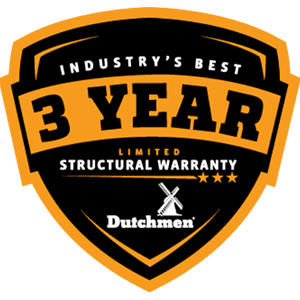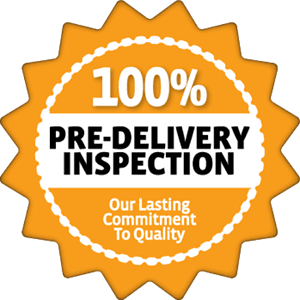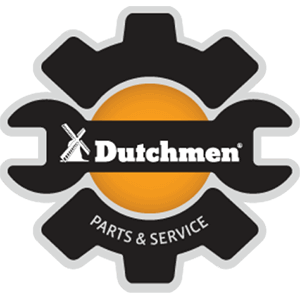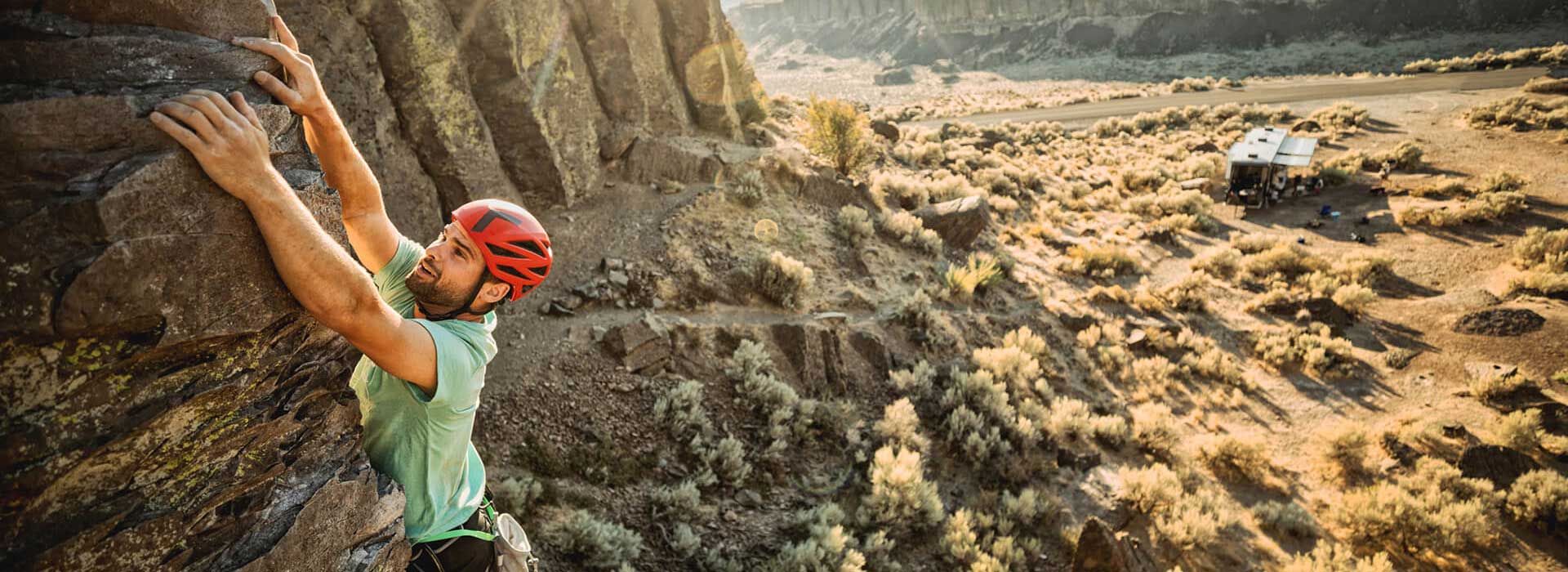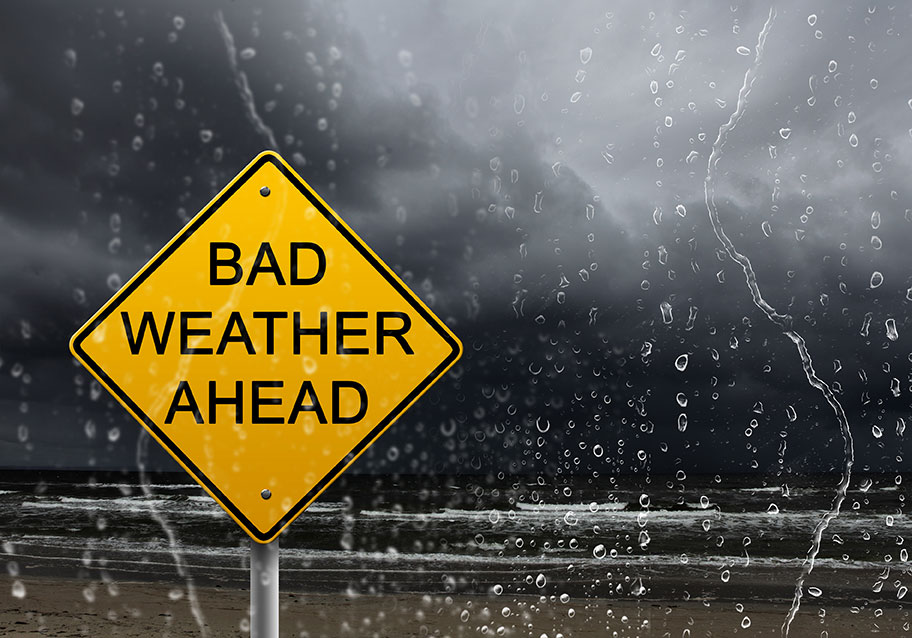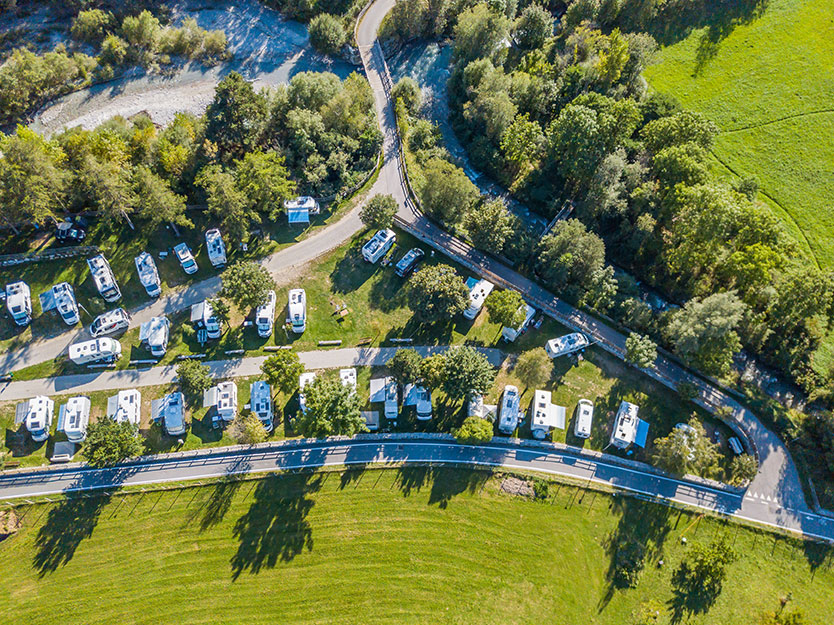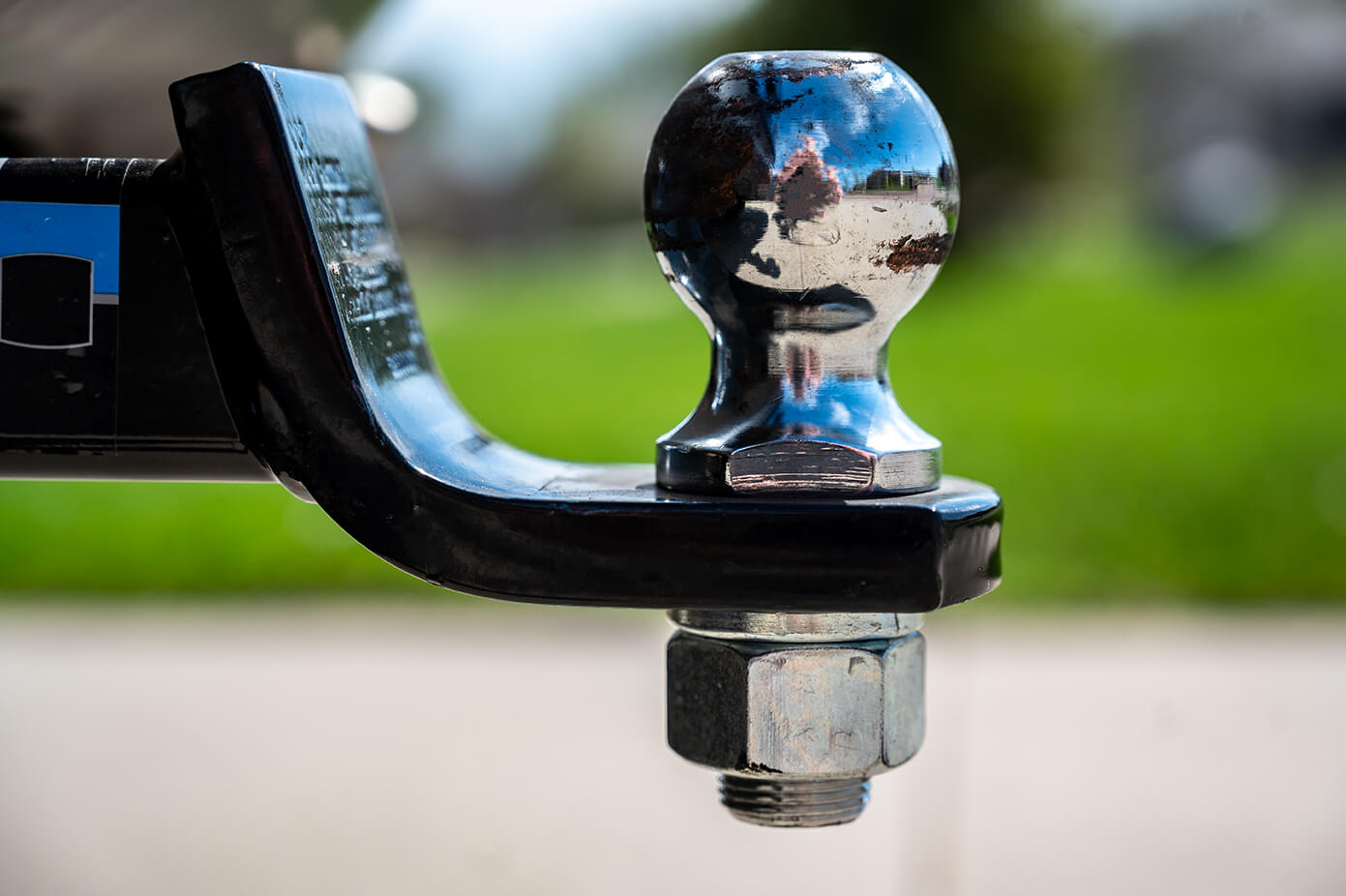Can I run my coffee maker and toaster at the same time without tripping the breaker? Can I walk on my roof? What about winterization or how to hook up Cable TV? All great questions.
Below, we've listed some of the most-asked questions to help you navigate the sometimes confusing, but always memorable world of RV living.
-
General
-
My dealer cannot get me in for warranty work until after my warranty expires, will the items still be covered?
Please contact Dutchmen Owner Relations at 1-866-425-4369 or fill out our contact form here, and we will gladly document your account with your current issues for consideration of warranty coverage. Please review your owner’s manual for clarification of warranty coverage and limitations.
-
Where can I obtain an Owner’s Manual?
Dutchmen provides an owner’s manual for each unit we manufacture. These manuals are not unit specific. The Dutchmen Owner’s Manual, both current and past, are posted on this website and can be downloaded in its entirety or by the page. (Download Here).
Note: For appliance owner’s manuals, contact the respective component manufacturer direct. -
How do I obtain parts for my Dutchmen product?
Our Dutchmen dealer network is the exclusive distributor of Dutchmen RV parts. Utilize the dealer locator provided on this website to find the dealer nearest you. Your satisfaction is very important to us. Should you need additional assistance in finding a dealer or experience difficulty obtaining the parts you need, please feel free to contact Customer Service by using the form here or at 866-425-4369.
-
How can I obtain schematics of my Dutchmen product?
Dutchmen RV Company does not publish schematics or diagrams of our products. Should a technical concern arise, we recommend contacting your local Dutchmen dealer. If you should need additional assistance, please feel free to contact us by using the form provided here or by phoning our “Retail Department” at 866-425-4369.
-
How do I winterize/de-winterize my unit?
Please visit our Video Gallery. We have several technical videos available in our video library. Please select the How to Winterize Your RV’s Water System video for further direction. You may also reference the plumbing systems chapter in our Dutchmen Owner’s Manual. For additional help, we recommend contacting your local Dutchmen dealer.
-
What do the different “Weight Rating” abbreviations mean?
The Recreational Vehicle Industry Association (RVIA) has adopted the following definitions:
• GVWR (Gross Vehicle Weight Rating) means the maximum weight limit of the unit. The GVWR is equal to or greater than the sum of the Unloaded Vehicle Weight plus the Net Carrying Capacity.
• UVW (Unloaded Vehicle Weight) is the weight of the unit as built at the factory. This includes full fuel tanks, full generator fuel tanks, engine oil and coolants (if applicable). The UVW does NOT include cargo, fresh water, LP gas or dealer-installed accessories.
• NCC (Net Carrying Capacity) is the maximum weight of all personal belongings food, fresh water, LP gas, tools, dealer-installed accessories and other items that can be carried by the unit.
• GCWR (Gross Combined Weight Rating) is the value specified as the maximum allowable loaded weight of a tow vehicle and a towed trailer or towed vehicle. -
Where can I locate the Serial number (also called Vehicle Identification Number) of my RV?
Your Bill of Sale, Insurance paperwork, Registration or Title will have the Serial number listed. On the unit it would typically be stamped on a tag which is mounted on the A-frame of a Travel Trailer or on the pin box of a Fifth Wheel. It would also be located on the Federal Certification Label on the forward roadside of the unit.
-
Why do I have to fill out a W9 for a reimbursement?
Dutchmen RV is a subsidiary of Thor Industries, a publicly traded company. It is the position of Thor Industries that we must have a Federal Identification Number on record documenting any outgoing payment of funds. This is accomplished by the payee completing a W-9 form. Note: By providing this information, it does not automatically indicate that any payment you receive from Dutchmen would be subject to Income Tax, however, Dutchmen cannot provide you with any tax advice so we would recommend you discuss your specific situation with your tax professional to determine your tax liability, if any, as a result any payments from Keystone RV Company.
-
My dealer cannot get me in for warranty work until after my warranty expires, will the items still be covered?
-
Electrical
-
What is the difference between 12 Volt & 120 Volt Electricity?
12 Volt-Direct Current (DC). 12 volt is the type of electricity you would find in an automobile. Your battery is the foundation for the 12 volt system in your RV. A fully charged battery will operate the 12 volt equipment (furnace, water heater, most lighting, range hood, monitor panel, roof vent fans, etc.) in your unit until the battery becomes discharged.
120 Volt-Alternating Current (AC). 120 volt is the same type of electricity you typically find in a home. Plugging your shoreline cord into a power source (campground or other appropriate receptacle) is the foundation for the 120 volt system in your unit (optional generators produce 120 volt electricity as well). Certain equipment (Roof Air Conditioner, microwave, most televisions, DVD players, etc) in your RV can only operate from 120 volt electricity thus require the unit be plugged in to a power source or a generator running.
Backup systems which are a part of your RV’s electrical system. Your unit is also equipped with a “Converter”. When the shoreline cord is plugged into a campground (or other appropriate receptacle), this device “Converts” 120 volt electricity into 12 volt electricity. The “converter” is also equipped with a “battery charger” which provides a “trickle charge” (slow, low amperage charging) to your battery as long as the shoreline is plugged in to a power source. -
What is the difference between an “automotive” and a “deep-cycle” battery?
An “automotive” type battery, like in your car, is designed to provide a “heavy load” (like during starting) for a short period of time and to be recharged continuously. A “deep-cycle” battery is designed to be slowly discharged (like during camping) and recharged over and over. While an “automotive” battery will work in an RV, the life expectancy is very short compared to the “deep-cycle” battery which was designed for this type of use.
-
How important is maintaining the battery on my unit?
Very Important! The battery in your RV is the foundation for the entire 12 volt system. Without a good battery, any 12 volt component in your RV can experience intermittent operational problems which can be extremely frustrating. This continuous discharging & charging is very hard on your battery. Be sure the water levels are checked at least monthly and the connections are kept clean and free of corrosion.
-
I lost power to some of the receptacles and the circuit breaker in the “Power Center” is not tripped?
Per Recreational Vehicle Industry Association (RVIA) code, certain receptacles in every unit are protected by a Ground Fault Circuit Interrupter (GFCI) system. Try pushing the reset button on the receptacle itself. The GFCI receptacles are typically located in the kitchen and/or bathroom. If the problem persists, try a different component in the receptacle. If the problem goes away, it could be a problem with the component. If the problem still persists, there could be an electrical issue in the trailer. To be safe, contact your nearest Dutchmen RV dealer to inspect and address the issue.
-
When I run a coffee maker and a toaster at the same time, why does the circuit breaker trip?
First, your RV is operating as designed. The receptacles in the RV are protected by a circuit breaker and/or the GFCI system. Hair Dryers, curling irons, toasters, coffee makers, etc. use a very high amount of electricity (amperage). Each circuit is rated at 15 amps. Typically, any combination of two of these types of accessories will draw more than 15 amps which will cause the breaker to trip. It may be necessary to operate any one of these types of accessories at a time. Please visit Our Video Gallery. We have several technical videos available in our video library.
-
What causes the ground fault circuit interrupter (GFCI) to trip?
The GFCI is a personal protection device that constantly monitors the flow of current through a protected circuit and senses any loss of current to an outside path. If the current flowing into an electrical appliance or fixture differs by a very small amount from what flows back out, the GFCI instantly interrupts the current flow.
-
How do I hook up Cable TV?
If your unit is equipped with an exterior cable TV jack; hook the “Park Cable” to the exterior jack. Turn the TV Antenna power booster (located inside the unit) to the “off” position (in some units, turn the booster to the “Cable” position). Turn the TV to the appropriate channels to receive cable. Note: depending on the TV set, it may be necessary to reprogram the TV from “Air” to “Cable”.
If your unit is not equipped with an exterior cable TV jack, it would be necessary to run the “Park Cable” direct to the TV set (through a window, etc.). -
How do I hook up an outside satellite antenna?
If your unit is equipped with an external satellite jack, hook the satellite antenna to the jack and hook the satellite receiver to the connection provided inside.
If your unit is not equipped with a satellite connection, run a cable directly from your satellite dish to the receiver. The cable hook-up that is provided with some units will not carry the satellite signal. As always, please refer to your Owner’s Manual for installation and troubleshooting information.
-
What is the difference between 12 Volt & 120 Volt Electricity?
-
Exterior
-
Can I add a rear hitch to my RV?
Some Dutchmen products are equipped with a receiver for bike rack use only. Any additions or modifications to our units would void the warranty. Please see your Owner’s Manual in regards to modifications.
-
How do I drain my holding tanks?
Remove the termination cap outlet, connect the sewer hose (adaptor) to the termination end, place the other end into an approved dump station inlet, and open the black (sewer) water termination valve first. Once dumping slows down, open the gray water termination valve (if unit is equipped with 2 gray water tanks, dump one at a time). Once contents are dumped, close termination valves. Next, flush sewer tank with water by opening termination valves one at a time until empty. Then, close termination valves, disconnect the sewer hose and store, install termination cap, and add approved chemical deodorant as per manufacturer instructions.
-
Can I walk on my rubber roof?
If your unit does not have a ladder please do not walk on the roof. In a case where your unit has a ladder, please pay attention to weight restrictions on the ladder equipped on the RV. Please take ordinary safety precautions and do not take unnecessary risk. Do not allow children to climb ladders or be on the roof. Please contact your dealership if you have more questions regarding roof structure, maintenance, service, and warranty items. You may also contact Dutchmen by filling out the form provided here or over the phone at 1-866-425-4369.
-
I noticed some air bubbles in my rubber or TPO roof, will they cause any problem?
During the manufacturing process, the glue used to secure the roofing material to the plywood underlayment goes through a “curing” process. In some instances, the glue continues to “cure” after the roof material is in place and the gas causes an air pocket. Typically, they will never get any larger and do not pose any threat for leakage or structural problems. If your unit has one that is making you uncomfortable, have your dealer check it for your piece of mind.
-
What should I use to coat my roof?
Nothing! The only maintenance to the roof material itself is washing it a few times a year. Most standard household detergents combined with warm water are appropriate (avoid petroleum based solvents, harsh abrasives or citrus based products). Keep debris cleared to help avoid stains.
Note: While the rubber or TPO roof material itself is relatively maintenance free, any sealed openings in the roof do require periodic inspections & resealing, typically every 3-6 months. Please review the Owner’s Manual for more information on the Care & Maintenance of your RV. -
What should I use to clean the fiberglass/metal siding of my RV?
Use automotive/Marine grade “Non-abrasive” cleaners & waxes with a soft cloth. Avoid products with ammonia, caustic harsh cleaners and rubbing compounds. Avoid high-pressure washers, rotating brushes, etc. around graphics or painted areas. Do not “dry wipe” surfaces.
-
Can I add a rear hitch to my RV?
-
Interior
-
How do I combat condensation and what will it hurt if I don’t?
Condensation needs to be taken seriously! Ignoring it can damage the RV which is not warrantable and most importantly could lead to mold issues which could be a health hazard. The key to controlling condensation is ventilation. A family in the course of normal use (breathing, bathing, cooking, washing dishes, wet towels/clothes, etc.) can put gallons of moisture (water) into the air. If that moisture is unable to escape the RV, you will experience condensation.
Tips to proper ventilation: crack a window, crack the roof vents, utilize the roof fans when showering, use the range hood fan when cooking or washing dishes, avoid hanging wet towels/clothes inside to dry. If these basic tips are unsuccessful in controlling condensation, it may even be necessary to consider purchasing a dehumidifier. (See your Owner’s Manual for further information regarding controlling indoor air quality).
-
How do I combat condensation and what will it hurt if I don’t?

